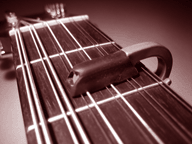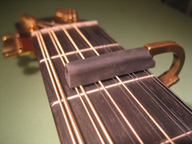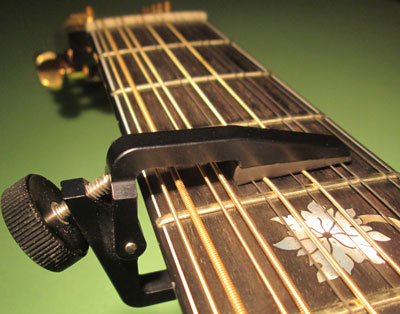 Partial
Capo Tips for the 12-String Guitar
Partial
Capo Tips for the 12-String Guitar
12-string players will find their own set of advantages and problems with the partial capo. Here are some things to think about...
Leo Kottke showed the way to the roaring sound of an open-tuned 12-string. With a partial capo you can quickly get that same basic sound, with a lot less retuning. You can hear about a dozen songs and instrumentals I have recorded with a partially capoed 12-string on iTunes by locating them on this list.
OFFSETTING A DROP E CAPO You won't need a Drop E-type capo (both Shubb and Kyser make them) with the wider neck of a 12-string, and you can almost certainly just offset a regular 6-string capo to capo the (0 2 2 2 2 2) and (2 2 2 2 2 0) type configurations. Also the (0 4 4 4 4 4) etc. Here is a Shubb c8b and a Liberty FLIP Model 43.


CLAMPING FORCE Because of the extra force required to clamp a 12-string, you may have trouble with the spring-action Kyser capos unless your strings are light and your action is pretty low. With a thicker neck, which many 12-strings have, the spring capos may also pull sideways and not do their job properly.
NECK WIDTH ISSUES Because 12-string often have wider necks and different string spacings, the single purpose Esus capos made by Shubb and Kyser may not be long enough, especially if you try to put them at the 5th or 7th frets, because most fingerboards get wider as you go up the neck. Because the "foot" of the Shubb c7b is slightly longer than the Kyser Short Cut, the Shubb c7b will generally work at fret 2 of a 12-string (and you might be lucky enough to have it work at fret 4, but likely no higher), and the Kyser Short Cut generally will not. The Liberty FLIP Model 43 is probably your best bet for 3 or 4-string capos since it has superior reach and clamping power.
OTHER ISSUES The universal capo Third Hand can handle any string spacing, and the double elastic straps have proven to be able to handle most situations.
To get an Esus capo to work on a wide-neck 12-string, your best choice is a Liberty Model 43, or to modify a Shubb c8b Drop E capo. The 3-string "foot" of the Liberty capo will work for a lot of guitars, and the longer "foot" on the other side gives you another set of options. It's not as simnple to shorten the anodized aluminum, and you'll need a good file or hacksaw. You can easily file down or saw off the Shubb's soft brass in a few minutes with a metal file or hacksaw, and snip the rubber sleeve with scissors. If you make the Esus part of the capo as big as it can be and still work at the 2nd fret (without bumping the adjacent strings) then it will generally work fine up the neck in the higher positions.
The other universal partial capo, the SpiderCapo, will not work on 12-string due to the design of the levers that clamp the strings. It also does not have enough clamping force.
A-STRING PROBLEMS You may have trouble getting the octave A string to capo properly, since the two strings in the pair are such different diameters. This is also a good reason to make your own Esus capo (above) because a factory Shubb Esus (c7b) capo has the rubber "foot" angled out, so you will likely only have rubber and no metal underneath it right at that spot where it clamps the 5th string pair. If you cut down a c8b capo you can make sure there is some metal above that crucial spot above the octave 5th string.
